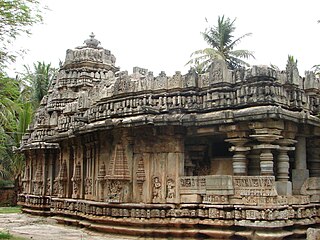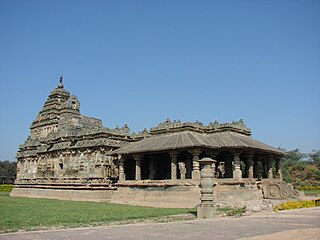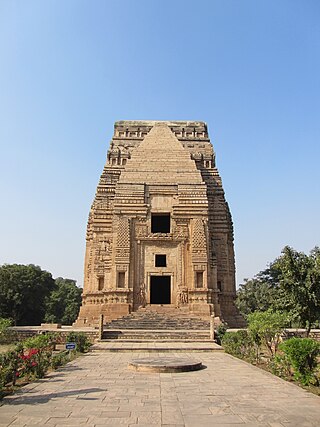Related Research Articles

Halebidu is a town located in Hassan District, Karnataka, India. Historically known as Dwarasamudra, Halebidu became the regal capital of the Hoysala Empire in the 11th century CE. In the modern era literature it is sometimes referred to as Halebeedu or Halebid as the phonetic equivalent, a local name after it was damaged and deserted after being ransacked and looted twice by the forces of the Turko-Persian Delhi Sultanate in the 14th century.

Hindu temple architecture as the main form of Hindu architecture has many varieties of style, though the basic nature of the Hindu temple remains the same, with the essential feature an inner sanctum, the garbha griha or womb-chamber, where the primary Murti or the image of a deity is housed in a simple bare cell. For rituals and prayers, this chamber frequently has an open space that can be moved in a clockwise direction. There are frequently additional buildings and structures in the vicinity of this chamber, with the largest ones covering several acres. On the exterior, the garbhagriha is crowned by a tower-like shikhara, also called the vimana in the south. The shrine building often includes an circumambulatory passage for parikrama, a mandapa congregation hall, and sometimes an antarala antechamber and porch between garbhagriha and mandapa. In addition to other small temples in the compound, there may be additional mandapas or buildings that are either connected or separate from the larger temples.

The Somanath temple or Deo Patan, is a Hindu temple located in Prabhas Patan, Veraval in Gujarat, India. It is one of the most sacred pilgrimage sites for Hindus and is the first among the twelve jyotirlinga shrines of Shiva. It is unclear when the first version of the Somnath temple was built, with estimates varying between the early centuries of the 1st millennium and about the 9th century CE. The temple is not mentioned in ancient Sanskrit texts of Hinduism as Somnath nomenclature, but the "Prabhasa-Pattana" is mentioned as a tirtha, where this temple exists. For example, the Mahabharata in Chapters 109, 118, and 119 of Book 3, and Sections 10.45 and 10.78 of the Bhagavata Purana state Prabhasa to be a tirtha on the coastline of Saurashtra.

Belur is a town and taluk in Hassan district in the state of Karnataka, India. The town is renowned for its Chennakeshava Temple dedicated to Vishnu, one of the finest examples of Hoysala architecture and the largest Hindu temple complex that has survived from pre-14th-century Karnata-Dravida tradition. A historic site inspired by the teachings of Ramanujacharya, it has been a Vaishnava Hindu pilgrimage center since at least the 12th century. It was also the first capital of the Hoysala dynasty, before they built Dwarasamudra.

The Kailasanathar Temple, Kanchipuram, also referred to as the Kailasanatha temple, is a Pallava-era historic Hindu temple in Kanchipuram, Tamil Nadu, India. Dedicated to Shiva, it is one of the oldest surviving monuments in Kanchipuram. It reflects a Dravidian architecture and was built about 700 CE by Narasimhavarman II with additions by Mahendravarman III. A square-plan temple, it has a mukha-mandapa, a maha-mandapa and a primary garbha-griya (sanctum) topped with a four-storey vimana. The main sanctum is surrounded by nine shrines, seven outside and two inside flanking the entrance of the sanctum, all with forms of Shiva. The outer walls of the temple's prakara (courtyard) is also surrounded by cells.

Lakkundi, also referred to as Lokkugundi, was a major city prior to the 14th century, and is now a village in Gadag District of Karnataka, India. By 10th century, it was already a major economic and commerce center with mint operations for South India, one mentioned in Kannada and Sanskrit inscriptions and texts. By 12th century, many Hindu and Jain temples had been consecrated here, along with public infrastructure such as stepwells and water reservoirs. Among the major temples are the Brahma Jinalaya (oldest), Mallikarjuna, Lakshminarayana, Manikeshwara, Naganatha, Kumbheshvara, Nanneshwara, Someshwara, Narayana, Nilakanteshwara, Kasivisesvara, Virabhadhara, Virupaksha, and others. As its importance and wealth grew, Lakkundi became one of the capitals of the Hoysala Empire.
Digambara Terapanth is one of the sects of Digambara Jainism, the other being the Bispanthi sect. It formed out of strong opposition to the religious domination of traditional religious leaders called bhattarakas during the 12th-16th century A.D, for the bhattarakas starting deviating from the original/Mula jain customs. They oppose the worship of various minor gods and goddesses. Some Terapanthi practices, like not using flowers in worship, gradually spread throughout most of North Indian Jainism as well.

The Kasivisvesvara temple, also referred to as the Kavatalesvara, Kashivishveshvara or Kashi Vishvanatha temple of Lakkundi is located in the Gadag district of Karnataka state, India. It is about 12 kilometres (7.5 mi) from Gadag city, between Hampi and Goa. The Kasivisvesvara temple is one of the best illustrations of fully developed Kalyana Chalukya style of Hindu architecture.

The Bhutanatha group of temples are 7th to 12th century Hindu temples to the east of Agastya lake in Badami, Karnataka state, India. It consists of two subgroups – one called the East Bhutanatha group or Bhutanatha main group from 7th to 8th-century mostly in the Dravida architecture style; the other called the North Bhutanatha group or Mallikarjuna group from 11th to 12th-century mostly in the Nagara architecture. The former illustrates the Badami Chalukya architects, the latter along with the nearby Yellamma temple the Kalyani Chalukya architects.
William Norman Brown was an American Indologist and Sanskritist who established the first academic department of South Asian Studies in North America and organized the American Oriental Society in 1926. He was the Professor of Sanskrit at the University of Pennsylvania for most of his academic career. He was president of the Association for Asian Studies in 1960. He is considered the founder of the field of South Asian Studies, which he pioneered in his career over four decades at the University of Pennsylvania, where he helped to found the Department of Oriental Studies (1931), and later single-handedly founded the Department of South Asia Regional Studies (1948). These departments are now survived by the departments of East Asian Languages and Civilizations, Near Eastern Languages and Civilizations, and South Asia Studies. W. Norman Brown also founded the American Institute of Indian Studies, which was located in the Van Pelt Library at the University of Pennsylvania. Brown was elected to the American Philosophical Society in 1946.

The Brahmeshvara temple, also referred to as the Brahmeshwara or Brahmesvara temple, is a 12th-century Hindu temple with Hoysala architecture in Kikkeri village, Mandya district of Karnataka state, India. Along with two other major historic temples within the village, the Brahmeshvara temple is one of many major ruined temples with notable artwork in Kikkeri area close to the more famous monuments of Shravanabelagola.

The Durga temple is an early 8th-century Hindu temple located in Aihole, Karnataka, India. Originally dedicated to Surya, it has the most embellished and largest relief panels in Aihole depicting artwork of Shaivism, Vaishnavism, Shaktism and Vedic deities. Apart from its fine carvings, it is notable for its apsidal plan – a rare example among early Chalukyan Hindu temple architecture.

Chaya Someswara Temple, also known as the Chaya Someshvara Swamy Alayam or the Saila-Somesvara temple, is a Saivite Hindu temple located in Panagal, Nalgonda district of Telangana, India. It was built around the mid 11th-century during the rule of the Kunduru Chodas, supported and embellished further by later Hindu dynasties of Telangana. Some date it to late 11th to early 12th-century.

Stella Kramrisch was an American pioneering art historian and curator who was the leading specialist on Indian art for most of the 20th century. Her scholarship remains a benchmark to this day. She researched and taught Indian art history for more than six decades on three continents. After writing her dissertation on the essence of early-buddhist sculpture in India, she was invited to teach at Kala Bhavana in Shantiniketan (1922–24) and went on to teach at Calcutta University from 1924 to 1950. In Europe, Kramrisch worked at the Courtauld Institute, London (1937–1940). From 1950, she was professor at the University of Pennsylvania in the Department of South Asia Regional Studies, where she had been recruited by W. Norman Brown, in addition to being a prominent curator at the Philadelphia Museum of Art.

The Brahma Jinalaya, sometimes called as the Greater Jain Temple of Lakkundi, is an early 11th-century Mahavira temple in Lakkundi, Gadag District of Karnataka state, India. The temple is attributed to Attiyabbe, the wife of the local governor Dandanayaka Nagadeva. It faces east, has a mukhamandapa, a gudhamandapa and its sanctum is covered by a sur-temple style vimana superstructure. The temple is notable for its reliefs depicting Jaina artwork, statues of the Tirthankaras and the two statues of Brahma and Saraswati inside its inner mandapa.

The Masrur Temples, also referred to as Masroor Temples or Rock-cut Temples at Masrur, is an early 8th-century complex of rock-cut Hindu temples in the Kangra Valley of Beas River in Himachal Pradesh, India. The temples face northeast, towards the Dhauladhar range of the Himalayas. They are a version of North Indian Nagara architecture style, dedicated to Shiva, Vishnu, Devi and Saura traditions of Hinduism, with its surviving iconography likely inspired by a henotheistic framework.

Teli ka Mandir, also known as Telika Temple, is a Hindu temple located within the Gwalior Fort in Madhya Pradesh, India. Dedicated to Shiva, Vishnu and Matrikas, it has been variously dated between the early 8th and early 9th century CE.

Badami Shivalaya refers to one of three 6th to 8th-century CE Hindu temples in Badami, Bagalkot district of Karnataka, India. They illustrate the early Chalukya style, and are among the better preserved illustrations of Dravida Hindu architecture. They are close to the Badami cave temples and other structural temples near Agasthya lake, but the Badami Shivalyas are located near or on top of different hillocks. These include the Upper Shivalaya, Lower Shivalaya and the better preserved Mallegitti Sivalaya found to the north of the Badami town. These temples include Shiva, Vishnu and Devi-related artwork, as well as depict legends from the Ramayana and Mahabharata.

Nachna Hindu temples, also referred to as Nachana temples or Hindu temples at Nachna-Kuthara, in Panna district, Madhya Pradesh, India are some of the earliest surviving stone temples in central India along with those at Bhumara and Deogarh. Their dating is uncertain, but comparing their style to structures that can be dated, some of the Nachna temples are variously dated to the 5th- or 6th-century Gupta Empire era. The Chaturmukha temple is dated to the 9th century. These temples illustrate a North Indian style of Hindu temple architecture.
Pushkar Sohoni is an architect, and an architectural and cultural historian. He is an associate professor and the chair of the department of Humanities and Social Sciences at the Indian Institute of Science Education and Research, Pune.
References
- ↑ "Homepage of Michael W. Meister".
- ↑ "School of Arts and Sciences : Meister Profile". University of Pennsylvania. Retrieved 19 July 2011.
- ↑ "The home page of Michael W. Meister". The Homepage of Michael W. Meister.
- ↑ Meister, Michael W. (2010). Temples of the Indus: Studies in the Hindu Architecture of Ancient Pakistan. Leiden: Brill. pp. xviii, 174. ISBN 9789004186170.
- ↑ Babb, Lawrence A.; Cort, John E.; Meister, Michael W. (2008). Desert temples: Sacred centers of Rajasthan in historical, art-historical, and social context. Jaipur: Rawat Publications. pp. xiv, 208. ISBN 9788131601068.
- ↑ "Katherine Hacker". UBC.
- ↑ "Ajay Sinha". Mount Holyoke College. 30 September 2015.
- ↑ "Museum Appoints New Curator Of Indian And Himalayan Art". Philadelphia Museum of Art.
- ↑ "Pika Ghosh". UNC.
- ↑ "Chandreyi Basu". St. Lawrence University.
- ↑ "Tamara Sears". Yale Department of History of Art.
- ↑ "Profile: Melissa R. Kerin, Washington and Lee University".
- ↑ "Meet the Curators". VMFA.
- ↑ "Trustees and Staff". Rubin Museum.
- ↑ "Pushkar Sohoni". South Asia Studies, University of Pennsylvania.
- ↑ "IISER faculty". Indian Institute of Science Education and Research Pune.
- ↑ "Yael R. Rice". Amherst College.
- ↑ "Nachiket Chanchani". University of Michigan History of Art.